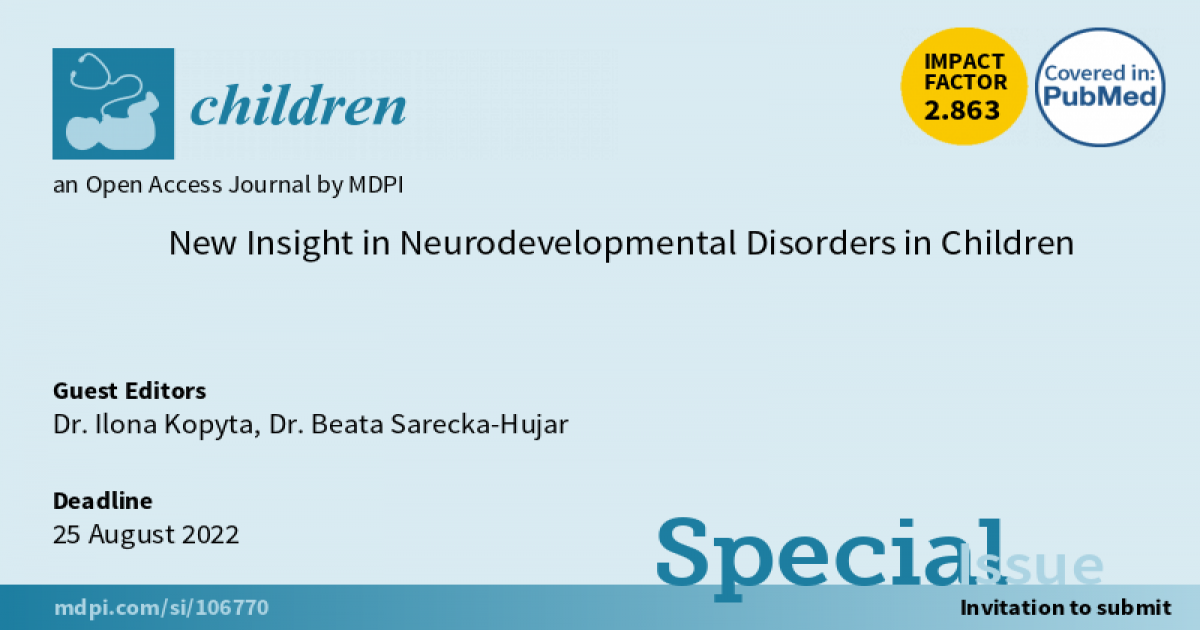New Insight in Neurodevelopmental Disorders in Children
A special issue of Children (ISSN 2227-9067). This special issue belongs to the section "Pediatric Neurology & Neurodevelopmental Disorders".
Deadline for manuscript submissions: closed (25 August 2022) | Viewed by 8030

Special Issue Editors
Interests: pediatric stroke; neurodevelopmental disturbances; epilepsy; headache; neuromuscular disorders; genetic disorders
Special Issues, Collections and Topics in MDPI journals
Interests: modern drug forms; liposomes; nanoparticles; microspheres; neurological diseases; metabolic disorders; skin; drug delivery; hydrogels; rheology; pharmaceutical technology; optimization and manufacturing of pharmaceutical products; quality of pharmaceutical forms
Special Issues, Collections and Topics in MDPI journals
Special Issue Information
Dear Colleagues,
Neurodevelopmental disorders are common problems encountered in the pediatric population.
The term “neurodevelopmental disorder” is broad and covers both genetically determined problems as well as those coming from environmental, infectious and traumatic causes. The occurrence of some of these disorders results from a multifactorial background. Some neurodevelopmental diseases have a specific clinical course and specific symptoms, while others have a very rich symptomatology, and the symptoms come from various organs and systems. Moreover, the appearance of concomitant symptoms changes the presentation of the underlying condition. Currently, the possibility of using modern research techniques (i.e., neuroimaging), and –especially the progress in the field of genetic diagnostics, makes it possible to recognize certain diseases and their causes with greater success and efficiency.
The idea of creating a Special Issue of Children on neurodevelopmental disorders in the pediatric population is to collect articles devoted to a modern approach to this group of diseases. The SI title allows for the inclusion of articles within this Issue describing the many and varied problems of developmental-age neurology, in accordance with the keywords given below.
In this Special Issue we would like to welcome articles, including original research articles, reviews, meta-analyses or case studies, which address the scope of neurodevelopmental problems in children.
Dr. Ilona Kopyta
Dr. Beata Sarecka-Hujar
Guest Editors
Manuscript Submission Information
Manuscripts should be submitted online at www.mdpi.com by registering and logging in to this website. Once you are registered, click here to go to the submission form. Manuscripts can be submitted until the deadline. All submissions that pass pre-check are peer-reviewed. Accepted papers will be published continuously in the journal (as soon as accepted) and will be listed together on the special issue website. Research articles, review articles as well as short communications are invited. For planned papers, a title and short abstract (about 250 words) can be sent to the Editorial Office for assessment.
Submitted manuscripts should not have been published previously, nor be under consideration for publication elsewhere (except conference proceedings papers). All manuscripts are thoroughly refereed through a single-blind peer-review process. A guide for authors and other relevant information for submission of manuscripts is available on the Instructions for Authors page. Children is an international peer-reviewed open access monthly journal published by MDPI.
Please visit the Instructions for Authors page before submitting a manuscript. The Article Processing Charge (APC) for publication in this open access journal is 2400 CHF (Swiss Francs). Submitted papers should be well formatted and use good English. Authors may use MDPI's English editing service prior to publication or during author revisions.
Keywords
- genetic syndromes
- pediatrics
- developmental disorders
- congenital brain anomalies
- epilepsy
- headache
- neuromuscular disorders
- cerebrovascular diseases
Benefits of Publishing in a Special Issue
- Ease of navigation: Grouping papers by topic helps scholars navigate broad scope journals more efficiently.
- Greater discoverability: Special Issues support the reach and impact of scientific research. Articles in Special Issues are more discoverable and cited more frequently.
- Expansion of research network: Special Issues facilitate connections among authors, fostering scientific collaborations.
- External promotion: Articles in Special Issues are often promoted through the journal's social media, increasing their visibility.
- Reprint: MDPI Books provides the opportunity to republish successful Special Issues in book format, both online and in print.
Further information on MDPI's Special Issue policies can be found here.







